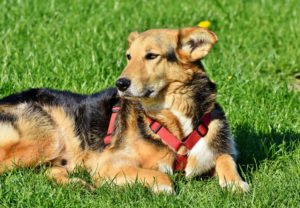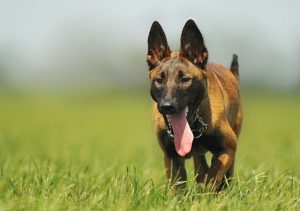Has your dog lost his bark, or the sound of his bark is raspy and lower than it used to be? Maybe your dog is coughing when eating and drinking water or his breathing is much more labored than it used to be.
If you dog is showing these symptoms, there is a chance that your dog might have the early signs of developing Laryngeal Paralysis. Laryngeal Paralysis in dogs is fairly common for older and large breed dogs. Most commonly affected are Labrador Retrievers, Newfoundlands, Golden Retrievers and Irish Setters.
I am going to cover what laryngeal paralysis in dogs is, what are the signs of laryngeal paralysis and treatment of laryngeal paralysis. I will also discuss how you can manage and live with laryngeal paralysis, as my Golden Retriever has had this disease for about 3 years.
Table of Contents
What Is Laryngeal Paralysis
Laryngeal Paralysis or also known as Lar Par, is when the muscles of the larynx become paralyzed. It is a condition that alters how the larynx works.
There are laryngeal muscles around the voice box or larynx. When the nerves of these muscles become weak, the muscles will relax and the cartilages collapse inward. With the muscles of the larynx becoming paralyzed, the larynx can not expand and it restricts a dog’s ability to breathe deeply.
When breathing in normally, at the opening of the trachea, the 2 sides are pulled open and relaxes when breathing out. When your dog has Lar Par, the muscles that normally pull the airway open don’t work properly. The walls of the airway don’t pull open, but rather are sucked into the opening, making it hard for your dog to breathe.
The larynx or voice box protects the lungs from aspiration during swallowing. It is also used for barking or growling and is the passage for air to the lungs.
There are some breeds of dogs that are prone to laryngeal paralysis from a very young age. This is a congenital form that affects Dalmatians, Rottweilers, Huskies, Pyreneas Shepherds and Bouvier des Flandres. The symptoms for these breeds will show up between 3-8 months old, and males are affected 3 times more often than females.
For dog’s that get Lar Par and it isn’t hereditary, the reasons for a dog getting Lar Par is most times unknown. Some of the reasons could include a trauma to the throat or neck, tumors, hormonal disease such as hypothyroidism or Cushing’s disease.
Signs of Laryngeal Paralysis
Usually the first sign that you will notice is a change in your dog’s bark or your dog losing their bark completely. My dog lost his bark completely, but that wasn’t enough for our veterinarian to realize that it was an early sign of laryngeal paralysis. They first thought that my dog had a type of bronchitis and was given antibiotics.

The 1st symptom you will probably notice is a change in your dog’s bark
His bark did eventually improve some, but a few months later it came back, and eventually my dog gave up trying to bark at all. It has been about 3 years now, and I am surprised that now once in a while he will try barking again. Sometimes there is a bit of a bark, but not the same bark he once had.
There are many other signs of laryngeal paralysis as the disease progresses.
- Heavy panting – even when they aren’t exerting themselves.
- Noisy respiration and a high-pitched sound when breathing in.
- Change in bark. Completely losing their bark, raspy bark or a change in the sound of their bark.
- Occasional coughing or sounding like they are trying to clear their throat.
- Reduced activity or exercise intolerance.
- Coughing when drinking or eating.
- Regurgitating or vomiting more frequently especially when eating.
- Loud, labored breathing.
- Prone to overheating under normal conditions. This is because they use their breathing to cool themselves and they are having a harder time breathing.
- Elevated temperature.
How To Help A Dog With Laryngeal Paralysis
As I mentioned, my dog has been living with Lar Par for around 3 years now. Things have definitely changed on what my dog is capable of doing now, but he is managing with some changes in his routine.
- Don’t use a chock collar. It is best if you change your dog over to a harness system.

It is best to use a harness on a dog with laryngeal paralysis
- Avoid hot environments. Humidity is very hard on a dog with laryngeal paralysis, and you will notice them struggling more during the humid hot months.
- Reduce strenuous exercise. I still walk my dog daily, but we go much slower and a shorter distance. I let him decide our pace and the distance. I do sometimes believe he is frustrated he can’t go further, but he still likes to get out there daily.
- Give your dog elevated food bowls. This will greatly help your dog with eating and drinking. My veterinarian recommended this when I mentioned the hard time he was having eating.
Treatment Of Laryngeal Paralysis
Your veterinarian might be able to determine your dog has Lar Par from a simple examination and from the symptoms you have noticed. If a more in depth examination is required, it could include a blood and urine test, chest radiographs or a laryngoscopy. The laryngoscopy will require your dog to be sedated.
In mild cases, it might be determined that there is no treatment needed with the exception of exercise restrictions and reduced stress. In mild situations your veterinarian might also prescribe anti-inflammatory medications, mild sedatives, antibiotics or a bronchodilator to help your dog.
Severe cases could involve surgery. A common surgery that is performed is called a tieback. Your dog would be sedated and your veterinarian would put a permanent suture on one side of your dog’s Arytenoid cartilage to the side of the larynx so air can pass through the larynx easier.
An incision is made on one side of your dog’s neck approximately 3-4″ long. The recovery is generally fairly short and easy.
Dog owners who have chosen this method of treatment have stated that it has dramatically improved their dog’s quality of life.
Severe cases could also include oxygen therapy or hospitalization. If your dog is ever in distress because a lack of oxygen, you need to take action immediately.
Additional Side Effects
There has been a very in depth study done by Bryden J. Stanley, an Associate Professor of Surgery at Michigan State University with several dogs that have acquired paralysis (not hereditary) that have shown another symptom. Her test was based on 32 dogs that were suffering with laryngeal paralysis.
Her study found that laryngeal paralysis is an early sign of a more general neurological degeneration. Is shows that in time the dogs exhibit generalized neurological deterioration. It is initially noticeable in your dog’s hind quarters around 1 year after original diagnosis.
I have also experienced this with my dog. At times his back ends just slightly drops. He is more unsteady on his legs and he has lost his confidence on being able to do some activities that he used to do. His back legs at times almost seem wobbly.
Review
If your dog is starting to show signs of possibly having Laryngeal Paralysis or Lar Par starting with when your dog lost his bark, is having problems breathing, coughing when eating or drinking or panting when he normally wouldn’t be panting, you should take your dog into your veterinarian to find out if your dog has laryngeal paralysis.
Elevating your dog’s bowls will greatly help your dog, and change your dog’s collar to a harness for walks.
Help your dog from overexerting themselves or from overheating. Only walk your dog as far as they are comfortable, allowing them to take breaks along the way. If it isn’t hot, don’t stop the walks though. They still enjoy getting out there, and it is better for them to get mild exercise.
My dog has been living with laryngeal paralysis for over 3 years now, and although he stresses us out sometimes with his coughing and not being able to walk far, he is still happy and interested in what is going on. We are just more conscious of our dog’s limitations. We elected not to do the surgery because of his age.
If you have any questions or comments, please leave them below. You can follow justforyourdog.com on Pinterest, FaceBook or Twitter.
Some of the links within this post are affiliate links, of which I might receive a small compensation from sales of certain items.





Hey Marla,
I’ve really enjoyed reading this article on as it’s informative and helpful. One of my neighbor has a Labrador and for a few days he didn’t bark at me. I’ve asked the owners what happened to their dog and they told me that they met a veterinarian and the dog was effected by Laryngeal Paralysis. His bark was sweet and I would be missing it. I’ll share this article with them as you’ve written it a detailed manner.
Thank you for taking your precious time in writing this post. Keep up the good work!
Thanks for reading and also for passing this article on to you neighbor. I am sorry that their dog has Laryngeal Paralysis. Their might be some information in my article to help them better prepare for what their dog is experiencing. With just a few simple changes, they will be able to make their dog more comfortable. The elevated dog bowls really helped my dog along with removing their collar and using a harness will help not make the situation worse.
When my vet told me my dog had Lar Par, I didn’t completely understand what that all meant, which is why I did more research on Lar Par, and from experiencing with my dog now for over 2 years, I feel I have a pretty good understanding of what is happening.
I will be passing this article on to my youngest daughter. We are all dog lovers, we have 3 altogether. My daughters 2, Blue Pitt-Emma, Beagle & Corgi mix-Frodo. And then my dog, a shichi-Mojo.
Guess you couldn’t guess who the alpha male is. LOL Mojo–all 5.1 lbs of him.
Of all the dogs I’ve listed, are they known for Lar Par?? Mojo sometimes cough, but I always figured it was due to his sinuses. He’s 4 years old. I don’t consider that old.
Thank you for this info, because I had never heard ot it.Laura
Laura, although any dog could get Laryngeal paralysis, the 3 dogs that you have are generally not considered dogs at high risk. They are not the breeds that are predisposed at risk at a young age, nor are they the larger breeds that tend to have issues as they get older. The likehood is fairly low for this to affect your dogs. That is good news for you. It is hard to watch your dog having problems breathing and it is a bit sad when they lose their bark.
Thanks for reading, and enjoy those dogs you have.
Marla, thank you for preparing this very detailed article on laryngeal paralysis. Thank you for including the information on the breeds that are predisposed to developing the problem at a very early age. This will allow me to speak with the breeder intelligently. Just to verify, dogs that do develop Lar Par can still make excellent pets with some accommodations. Yet, they should not be bred nor used as working dogs?
Thanks again.
Sonda, thanks for reading my article and for commenting. You are correct, dogs that are have Lar Par shouldn’t be bred, they can genetically pass it on to their litter. They do still make great dogs. My Golden Retriever got Laryngeal paralysis when he was about 9 years old. He is now over 11. A lot has changed in what he is able to do, but we have just modified his life to make it the best possible for him. He can no longer hunt, which he loved, and we only walk him as far as he wants to go. He let’s us know when it is time to quit. He still makes a great pet and companion.
Hi Marla-really helpful article on Lar-Par. My Golden boy, Riley, was diagnosed with it when he was being seen by an oncologist to treat his cancer. I was surprised to learn at the time about the lar par, as I was navigating the cancer diagnosis. Anyway, your article is very helpful and I’ve noticed improvements already, just by changing to raised bowls, using the harness, and being mindful when walking him. And with now that I know what I am dealing with, I can make other changes (as before the diagnosis, I just assumed his symptoms were caused by age. He is 11.5, but doesn’t seem to realize it, as he often still acts like puppy :). Thanks for the helpful article.
I am glad the information was helpful for you, but I am sorry you are dealing with both cancer and Lar-Par. We were going to get the surgey for our Golden, but we had a lump checked out first, and it too was cancer. Skipped the surgey. We ended up losing him when he was 12. He was just having too many problems breathing and we didn’t want him to suffer. He did have much harder days when the humidity was high. Tried to keep him in the air conditioning as much as possible to help him. I wish you well with both of your issues. If you have any questions, let me know. I have experienced both issues with my Goldens.
our dog Porter is a Newfie about 9 years old.he lost his bark perhaps 2 years ago can’t howl any longer but tries and we elevated his water bowls and hand feed him sitting up.Exercise him only moderately and he still likes to drink out of the stream and he likes to wade in the water but not swim.Its as if the cold water effects his legs.I’m wondering if an operation at 9 years old would be helpful and how much do those run.
If I would have know how long my dog was going to live, I would have had the surgery as soon as we knew what was wrong with him. His last several years were pretty miserable, but that was mainly from his Laryngeal Paralysis. I had said to my vet, “he is an old dog.” And my vet said it is an old dog’s issue. As for the cost of the surgery, that will vary on what they will need to do. I would check with your vet for the best information, but if I was to guess, I think around $1000-$1500. I wish I would have done it, but it is easier to see after the fact on what is the best decision. Go with your heart.
My Chocolate Labrador just had tie back procedure for laryngeal paralysis. While not cheap, it worked, so she can breathe better. She is 13 and recovering well. However, she lost her bark since procedure, although her bark was already changed from the condition. Now she she breathes better and we are grateful. Recovery involves slow feeding. It takes about three weeks. We wet her dry food and feed it one tablespoon at a time until stitches are removed, this is so no dry particles or dry food dust or particles goes into larynx while she heals. We also give her wet food in meatball sizes for her antibiotics and pain med. she is so much more comfortable and starting to love life again. No more shortness of breath or minor collapses as she tries to catch her breath. Procedure is worth it!
I am so glad to hear your dog is doing well after having the surgery for Lar Par. I wanted to do the same for my dog, but he already had other health issues at the time, so we decided against it. Thank you for sharing. That is great news that the surgey was able to help your dog. It is hard to watch them struggle when they can’t breathe well.
I have a 10 year old lab who recently has been gagging loudly periodically but not while eating or drinking. She is panting when she isn’t hot, and I have been having to lift her behind up into bed in the last few days. Tonight she was panting and she was actually eating ice cubes I was giving her. Should I be worried she has Lar Par?? I am so worried after all I have read.
If you haven’t gotten her checked out yet, I would. She should have additional problems when the weather is humid if she has Lar Par. It is managable, my dog lived with it for several years, but that is why we eventually had to put him down. If your dog does have Lar Par, try to help keep them cooler, and take much shorter walks at a slow pace.
I just found your article on Lar Par and am so glad I did. I have a 13.5 year old Aussie who has almost lost her bark, becoming more hoarse over the last year. The episodic laryngeal spasms and loud gasping noises seem to be getting worse. I was concerned about a mass. She does have a large soft mass to left axilla but is prone to lipomas. I’ve been keeping an eye on it. Her activity level is great. She does not do well in the heat- so we keep our A/C at 65 or less. I’ve been feeding her home cooked food. I’ve been feeding her while she lies down in her bed but then I noticed she would suddenly jump up mid feed. So I began spoon feeding her while she stood up. She has had several surgeries so I was wondering if scar tissue may have contributed. Should I be feeding her hard biscuits and her greenie? She loves those but we have cut back on biscuits. Your article was so great! Sorry for all the questions. Again, thanks so much for any recommendations.